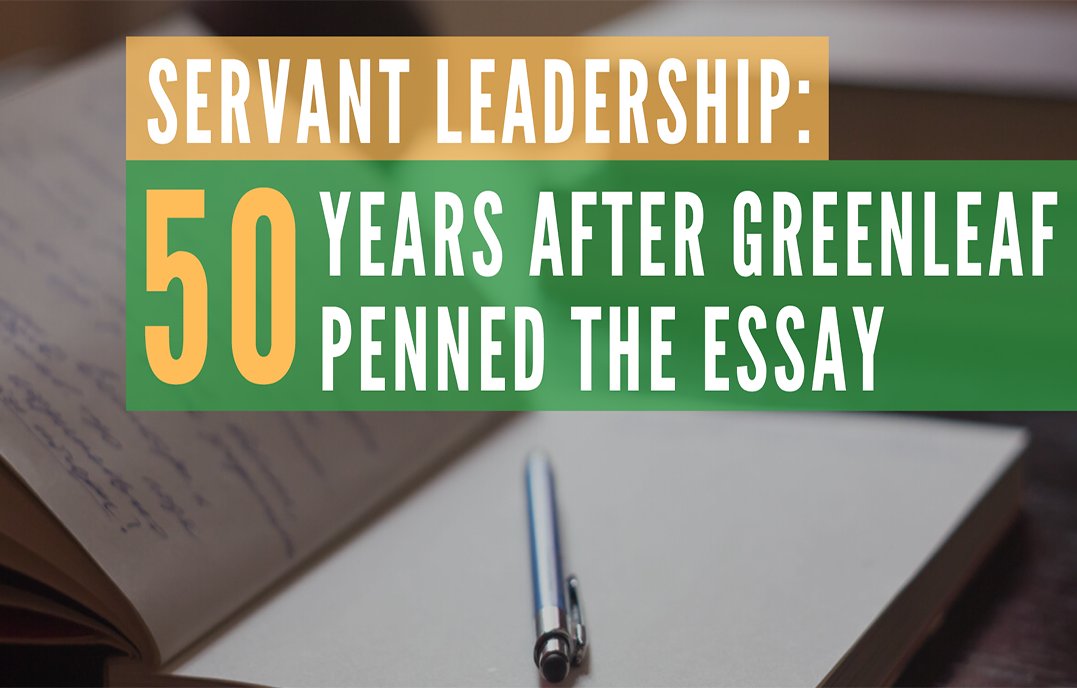The year 2020 marks the 50th anniversary of the origins of servant leadership. Robert K. Greenleaf was a mid-20th century iconoclast who argued that leaders should use their positions of power to help their teams succeed rather than for self-interest and personal glory. It’s a powerful concept that has been put to the test by many organizations, including Southwest Airlines and WD-40.
Servant leadership still has a strong appeal for today’s leaders who have a bias for stewardship. Yet, many people who practice servant leadership in the 21st century are unclear about its origins. Whether you’ve never heard of the term servant leadership or consider yourself naturally drawn to this style of leadership, you may be interested in learning more about how Greenleaf came to develop the concept.
Midwestern values. Greenleaf was born in Terra Haute, Indiana, and bred with strong midwestern values. He was one of the first leadership theorists to introduce the concept of spirituality into management systems. Yet, Greenleaf did not refer to his experience with organized religion as important in shaping his ideas about leading organizations. In his essay, Seeker and Servant: Reflections On Religious Leadership, Greenleaf wrote, “I treasure the Judeo-Christian tradition. I do not value it above other traditions, but it is the one in which I grew up. The great symbolic wisdom of this tradition grows on me day by day. I regret the dogma that people have built around this tradition, which limits access to it. I cringe when I think of the wars that have been fought and may yet be fought because of the human tendency to forge hard doctrine out of the stories by which the wisdom of people and events, which make our tradition, have been handed to us…Much as I value the tradition in which I live, I feel compelled to leave it a mite better than I found it.”
Change from the inside. Greenleaf attended Carleton College in rural Minnesota in the mid-1920’s. One day, he was struck by a lecture given by his Economics professor, who said, “We are becoming a nation of large institutions – government, churches, businesses, universities – and none of these big institutions are serving well, either the people whom they are set up to serve or the people who staff them to render the service. They can only be changed from the inside, by somebody who knows how to do it and who wants to do it. Some of you students should make your way inside these institutions and become the ones who help them do better.”
Greenleaf took this lecture to heart. When he graduated, he took a job with American Telephone & Telegraph, then the largest company in the world. He worked his way up to eventually become in charge of management development. As he studied the company’s expansive business units over the next four decades, he found that the ones that performed the best over time had leaders who operated outside of the traditional command-and-control model. This experience gave Greenleaf both the quantitative and qualitative basis for establishing a business case for servant leadership.
Of E.B. White, Quakers, and LSD. Greenleaf was a brilliant thinker and researcher with a voracious appetite for soul searching. He gleaned insight from thought leaders, spiritual groups, and psychedelic drugs alike. In My Debt to E.B. White, Greenleaf concludes that White was gifted with, “seeing things whole” and “the language to express what he saw,” were key to his power as a writer. In the Quaker practice of consensus, Greenleaf found a way of making group decisions that honored all voices using silence, listening, and the role of the Chair – or Clerk – as a first among equals, no better or worse than anyone else. When experiments with mind-altering drugs were emerging in the late 1950’s, Greenleaf participated in several guided sessions that resulted in what he described as “permanent learning” of the heightened perception of color.
The orange booklet. In the late 1960’s, Greenleaf wrote an essay called The Servant as Leader. In the essay, he wrote, “The pyramid organizational structure with its dominating leader is no longer adequate . . . Followers choose leaders – authentic moral leaders– because they have proven their willingness to serve and even risk losing leadership by ‘venturing out for the common good.’” The servant leadership model reversed the polarity of power. In effect, it turned the pyramid upside down. It was an antidote to the command-and-control model that had served as the natural order of doing business for hundreds of years. The orange-covered essay began to circulate in the halls of some of Americas corporations, became the tinder for spreading the model of servant leadership in the U.S., and is still in publication today.
Robert K. Greenleaf died on September 29, 1980. The Philadelphia Inquirer wrote that he was, “a management consultant who preached that the human spirit is more important than the bottom line.” According to biographer Don Frick, Greenleaf summed up his life through the epitaph on his tombstone: “Potentially a good plumber ruined by a sophisticated education.”
Question: What do you know about the origins of servant leadership?




